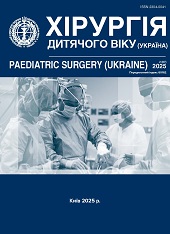Additional spleens in children. Literature review and own clinical observations
DOI:
https://doi.org/10.15574/PS.2025.2(87).94102Keywords:
developmental malformations, additional spleen, diagnostics, tactics, treatmentAbstract
Aim - to conduct a literature review analysis on accessory spleens in children and to establish the prevalence, number and localization, as well as modern visualization methods, features of the course and significant indications for surgical treatment.
Accessory spleens account for 10% to 30% of the population. The prevalence of additional spleens was established, which varied depending on the imaging method: verification using ultrasound, computer tomography, magnetic resonance imaging took place from 16.6% to 30.1%, intraoperative from 14.3% to 14.6%, and cadaveric from 0.6% to 9.1%. By the number of additional spleens, it was established that one additional spleen took place from 21.4% to 85%, and two or more from 25.0% to 64.3%. Additional spleens were localized in the splenic hilum from 41.7% to 75%, in lig.gastrolienale 15.0% to 54.0%. Surgical treatment - removal of the additional spleen is indicated only if it is complicated by volvulus, necrosis and suppuration, and isolated cases are described as clinical observations. There were 195 patients with additional spleens for 30 years, aged from 3 months to 18 years, of which 103 (52.82%) were male, 92 (47.18%) were female. Patients were divided into two groups: the first group 59 (30.26%) - inpatient surgical treatment of other ailments, the second group - 136 (69.74%), who were treated on an outpatient basis.
Conclusions. An additional spleen is a congenital anomaly that is usually asymptomatic, but can clinically manifest complications such as torsion, spontaneous rupture with bleeding, suppuration and cyst formation, which requires urgent examination and treatment, including surgical removal of the twisted additional spleen.
The authors declare no conflict of interest.
References
Abdullin RF, Kondratenko EG, Koshyk EA, Ivanov DV. (2014). The morphological characteristic of intrapancreatic accesory spleen at newborns and children of the first year of life. Sovremennaya Pediatriya. 2(58): 95-100. doi: 10.15574/SP.2014.58.95.
Alexander RC, Romanes A. (1914). Accessory spleen causing acute attacks of abdominal pain. Lancet. 184: 1089-1091. https://doi.org/10.1016/S0140-6736(00)96489-4
Bajwa SA, Kasi A. (2025, Jan). Anatomy, Abdomen, and Pelvis: Accessory Spleen. In: StatPearls [Internet]. Treasure Island (FL): StatPearls Publishing. URL: https://www.ncbi.nlm.nih.gov/books/NBK519040/?utm_medium=email&utm_source=transaction.
Bezrodnyi BH, Kolosovych IV, Hanol IV. (2014). Khirurhichne likuvannia zakhvoriuvan selezinky. Kyiv: Valrus Dyzain: 208. ISBN: 978-966-1562-08-9.
Di Serafino M, Verde F, Ferro F, Vezzali N, Rossi E, Acampora C et al. (2019, Dec). Ultrasonography of the pediatric spleen: a pictorial essay. J Ultrasound. 22(4): 503-512. https://doi.org/10.1007/s40477-018-0341-2; PMid:30446947 PMCid:PMC6838283
Gill N, Nasir A, Douglin J, Pretterklieber B, Steinke H et al. (2017). Accessory Spleen in the Greater Omentum: Embryology and Revisited Prevalence Rates. Cells Tissues Organs. 203(6): 374-378. Epub 2017 Apr 19. https://doi.org/10.1159/000458754; PMid:28420007
Matthew C, Rajendran R R (2023, May 18). Accessory Spleen Mimicking an Intrahepatic Neoplasm: A Rare Case Report. Cureus. 15(5): e39185. https://doi.org/10.7759/cureus.39185
Mayer A, Varga I, Kachlik D, Voller J, Fuljer I, Jackuliak P. (2025). Accessory Spleen: An Anatomical Variation or Developmental Defect? Surgical, Anatomical and Embryological Perspectives. Bratisl. Med. J. 126: 6-13 https://doi.org/10.1007/s44411-025-00042-7
Ren C, Liu Y, Cao R, Zhao T, Chen D et al. (2017, Sep). Colonic obstruction caused by accessory spleen torsion: A rare case report and literature review. Medicine (Baltimore). 96(39): e8116. https://doi.org/10.1097/MD.0000000000008116; PMid:28953636 PMCid:PMC5626279
Romer T, Wiesner W. (2012, Mar-Apr). The accessory spleen: prevalence and imaging findings in 1,735 consecutive patients examined by multidetector computed tomography. JBR-BTR. 95(2): 61-65. PMID: 22764656. https://doi.org/10.5334/jbr-btr.75
Rybalchenko VF, Urin OM, Brahynska SA, Mamontov DS, Rinzberh BS, Rozshchepii SO et al. (2019). Dodatkovi selezinky u ditei. Zbirnyk naukovykh prats za meterialamy naukovo-praktychnoi konferentsii 18-19 zhovtnia 2019 roku «Innovatsiini tekhnolohii v khirurhii ta anesteziolohii i intensyvnii terapii dytiachoho viku». m. Kyiv: 42-43.
Sadler TW. (2018). Langman's medical embryology. Lippincott Williams & Wilkins.
Scirè G, Zampieri N, El-Dalati G, Camoglio FS. (2013). Conservative management of accessory spleen torsion in children. Minerva Pediatrica. 65(4): 453-456.
Simon DA, Fleishman NR, Choi P, Fraser JD, Fischer RT. (2020, May 4). Torsion of an Accessory Spleen in a Child with Biliary Atresia Splenic Malformation Syndrome. Front Pediatr. 8: 220. https://doi.org/10.3389/fped.2020.00220; PMid:32432066 PMCid:PMC7212802
Trinci M, Ianniello S, Galluzzo M, Giangregorio C, Palliola R, Briganti V et al. (2019, Mar). A rare case of accessory spleen torsion in a child diagnosed by ultrasound (US) and contrast-enhanced ultrasound (CEUS). J Ultrasound. 22(1): 99-102. Epub 2019 Feb 13. https://doi.org/10.1007/s40477-019-00359-4; PMid:30758809 PMCid:PMC6430300
Vikse J, Sanna B, Henry BM, Taterra D, Sanna S, Pękala PA et al. (2017, Sep). The prevalence and morphometry of an accessory spleen: A meta-analysis and systematic review of 22,487 patients. Int J Surg. 45: 18-28. Epub 2017 Jul 15. https://doi.org/10.1016/j.ijsu.2017.07.045; PMid:28716661
Yildiz AE, Ariyurek MO, Karcaaltincaba M. (2013, Apr 21). Splenic anomalies of shape, size, and location: pictorial essay. ScientificWorldJournal. 2013: 321810. https://doi.org/10.1155/2013/321810; PMid:23710135 PMCid:PMC3654276
Downloads
Published
Issue
Section
License
Copyright (c) 2025 Paediatric Surgery (Ukraine)

This work is licensed under a Creative Commons Attribution-NonCommercial 4.0 International License.
The policy of the Journal “PAEDIATRIC SURGERY. UKRAINE” is compatible with the vast majority of funders' of open access and self-archiving policies. The journal provides immediate open access route being convinced that everyone – not only scientists - can benefit from research results, and publishes articles exclusively under open access distribution, with a Creative Commons Attribution-Noncommercial 4.0 international license(СС BY-NC).
Authors transfer the copyright to the Journal “PAEDIATRIC SURGERY.UKRAINE” when the manuscript is accepted for publication. Authors declare that this manuscript has not been published nor is under simultaneous consideration for publication elsewhere. After publication, the articles become freely available on-line to the public.
Readers have the right to use, distribute, and reproduce articles in any medium, provided the articles and the journal are properly cited.
The use of published materials for commercial purposes is strongly prohibited.

